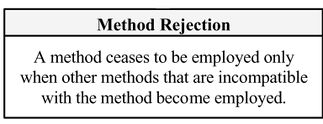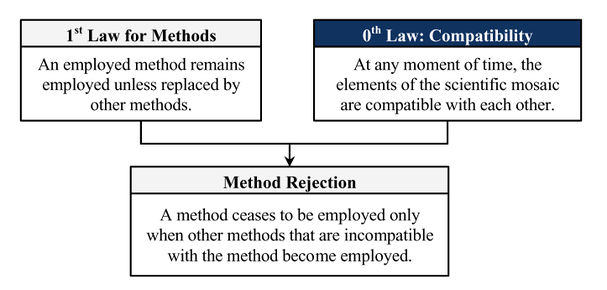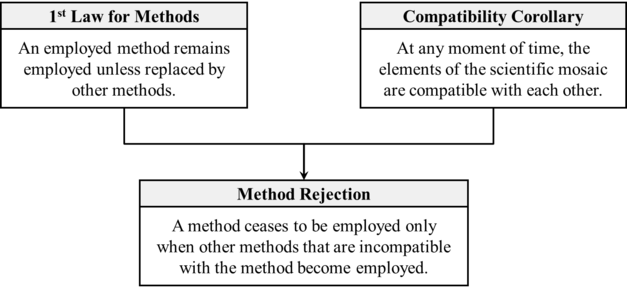Method Rejection theorem (Barseghyan-2015)
This is an answer to the question Mechanism of Method Rejection that states "A method ceases to be employed only when other methods that are incompatible with the method become employed."
Method Rejection theorem was formulated by Hakob Barseghyan in 2015.1
Contents
Scientonomic History
Initially, the method rejection theorem was accepted as deducible from the conjunction of the first law for methods and Harder's zeroth law. Barseghyan noted that this initial deduction was "similar to that of the theory rejection theorem. And just as its sibling theory rejection theorem, this theorem is also somewhat trivial".1pp. 174
We can use the short, hypothetical example from Barseghyan (2015) to illustrate the initial deduction of the method rejection theorem.
Say we have a set of accepted theories and a very simplistic method, which consists of only one requirement that can be roughly explicated as:
In order to become accepted, a new theory must explain all known facts with more precision and accuracy than they are explained by accepted theories. Suppose also that, as a result of changes in the accepted theories, some new method becomes employed. Question: what happens to this old method? Does it get rejected or does it still remain employed together with the new one?
The answer to this question depends on whether the two methods can be employed simultaneously. By The Zeroth Law (Harder-2015), if the requirements of the two methods are compatible with each other, then the old method remains employed together with the new one or, conversely, if the requirements of the two methods are incompatible, then the zeroth law dictates that the old method should go. ... If our new method has no conflict between its new requirement and the old one – the two are complementary. Therefore, the two requirements will become simultaneously employed. But what if the new method were incompatible with the old method? ... This new requirement voids the old requirement. Thus, the new method is in conflict with the old method. In this case, by the law of compatibility, the old method will have to go.1pp. 172-3
After the replacement of Harder's zeroth law with the compatibility corollary, suggested by Fraser and Sarwar, it became accepted that the method rejection theorem is a deductive consequence of the first law for theories and the compatibility corollary.2pp. 72-74
Acceptance Record
| Community | Accepted From | Acceptance Indicators | Still Accepted | Accepted Until | Rejection Indicators |
|---|---|---|---|---|---|
| Scientonomy | 1 January 2016 | The theorem became de facto accepted by the community at that time together with the whole theory of scientific change. | No | 22 February 2024 | The theorem was rejected as a result of the acceptance of modification Sciento-2023-0002. It was replaced by Norm Rejection theorem (Pandey-2023). |
Suggestions To Reject
These are all the modifications where the rejection of this theory has been suggested:
| Modification | Community | Date Suggested | Summary | Date Assessed | Verdict | Verdict Rationale |
|---|---|---|---|---|---|---|
| Sciento-2023-0002 | Scientonomy | 28 December 2023 | Accept new formulations of the first law for theories, norms, and questions that are in tune with the formulation of the first law. Also accept new formulations of the respective rejection theorems - theory rejection, norm rejection, and question rejection. | 22 January 2024 | Accepted | During the 2024 workshop, the bulk of the discussion centered around the inclusion of the first law for norms and norm rejection theorem in the set of formulations to be accepted. Paul Patton contended that norm employment in general had not been demonstrated to be lawful beyond method employment, and our basic formulations should instead concern norm acceptance, which is patently lawful. He argued that the formulations should be modified to pertain either to methods only or to norm acceptance. It was decided that if the community were to remain uncomfortable with accepting Pandey’s new formulations, a revote would likely also need to be taken on Rawleigh’s Sciento-2022-0002, given that the issue of norm employment was also highlighted in discussions of that modification. After extensive discussion, Barseghyan suggested that the first law for norms would only apply to situations where behavior was norm-guided to begin with, which would skirt the difficulty that faces even behavioural psychologists of determining whether human behaviour in general is lawful. The majority of the community was comfortable with this workaround, and the modification was ultimately accepted with over 2/3rds majority assenting, with 11/14 votes to accept (although 1 voter voted to reject the modification and 2 voted to keep it open). |
Question Answered
Method Rejection theorem (Barseghyan-2015) is an attempt to answer the following question: How do methods become rejected? What is the mechanism of method rejection?
See Mechanism of Method Rejection for more details.
Description
According to the method rejection theorem, a method ceases to be employed only when other methods that are incompatible with it become employed.
Reasons
Reason: Method Rejection Theorem Deduction
By the first law for methods, an employed method will remain employed until it is replaced by other methods. By the compatibility corollary, the elements of the scientific mosaic are compatible with each other at any moment of time. Thus, a method can only become rejected when it is replaced by an incompatible method or methods.1pp. 172-176 2pp. 72-74
This reason for Method Rejection theorem (Barseghyan-2015) was formulated by Patrick Fraser and Ameer Sarwar in 2018.2
If a reason supporting this theory is missing, please add it here.
Questions About This Theory
The following higher-order questions concerning this theory have been suggested:
If a question about this theory is missing, please add it here.
References
- a b c d Barseghyan, Hakob. (2015) The Laws of Scientific Change. Springer.
- a b c Fraser, Patrick and Sarwar, Ameer. (2018) A Compatibility Law and the Classification of Theory Change. Scientonomy 2, 67-82. Retrieved from https://scientojournal.com/index.php/scientonomy/article/view/31278.


